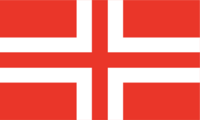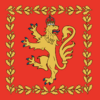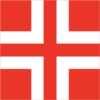Flag of Great Nortend
 | |
| Name | Great Cross of the Realm |
|---|---|
| Use | National flag |
| Proportion | 2:3 |
| Adopted | 1 April, 1870 |
| Design | A red cross on a white cross on a red field. |
| Designed by | Sir Almandy Fleurin, Lamanus King of Arms |
The national flag of Great Nortend is, by proclamation, the Great Cross of the Realm. Its design includes the Arms of St Christopher, the patron saint of the province of Hambria with the Cross of St George, one of the two patron saints of the province of Nortend, superimposed on top. It was first used during the reign of Alexander I, as the first King of Nortend, Cardoby and Hambria as part of the insignia of the Alexanderine Service Order. It was later adopted in 1870 by Henry VI as the national flag.
It is blazoned:
Gules, St Christopher's cross with the Cross of St George superimposed.
Protocol
The Great Cross is a symbol of the civil Government of Great Nortend. It is commonly flown in such contexts as by government buildings. For example, the Great Cross is flown on the main Government buildings at Fettercourt in Lendert-with-Cadell on all days of the year and when the Royal Standard is flown instead.
The flag is flown at half mast on certain mourning days as well, including:
- From the death of the Sovereign until the formal Accession of the new sovereign.
- From the death of a member of the Royal Family until the day of his funeral.
- From the death of the Archbishop of Sulthey until the day of his funeral.
- On the death of the Archbishop of Limmes or of Rhise.
- On the death of the present or former Officer of State.
- On the death of a foreign Sovereign
Flags
| Flag | Name | Use |
|---|---|---|

|
Great Cross | National flag. |

|
Royal Standard | Personal flag of the Sovereign. |

|
Square Cross | A small flag used as the military and government maritime jack. |

|
Red Ensign | Used as a military naval and aviation ensign by the Navy Royal. |

|
Blue Ensign | Used defaced by the government and certain incorporated entities as a maritime and aviation ensign. |

|
White Ensign | Used as the civil maritime and aviation ensign. |
All merchant vessels, commercial vessels, and pleasure craft registered in Great Nortend are required to fly the White Ensign at the stern during the daylight hours. Similarly, all aircraft registered in Great Nortend are required to fly the White Ensign from the cockpit during daylight hours when on the ground. Certain yacht clubs and flying clubs are entitled to fly a Blue Ensign, either defaced or undefaced. Some fly defaced White Ensigns or Red Ensigns. If flying anything other than the plain White Ensign, marinecraft must fly the corresponding burgee from the mainmast or jack to prove entitlement, and carry a warrant. No requirement to fly a burgee exists for aircraft, although the warrant must still be carried.
Vessels owned and operated by government ministries or departments such as those of Customs, the Post Office and the Trade Office fly a Blue Ensign defaced with a departmental badge. A plain Blue Ensign is flown by warranted harbourmasters and certain other officials. Similar flags are flown on land by government departments.
All Navy Royal vessels fly the Red Ensign at the stern, with the Square Cross as jack when moored or anchored.
